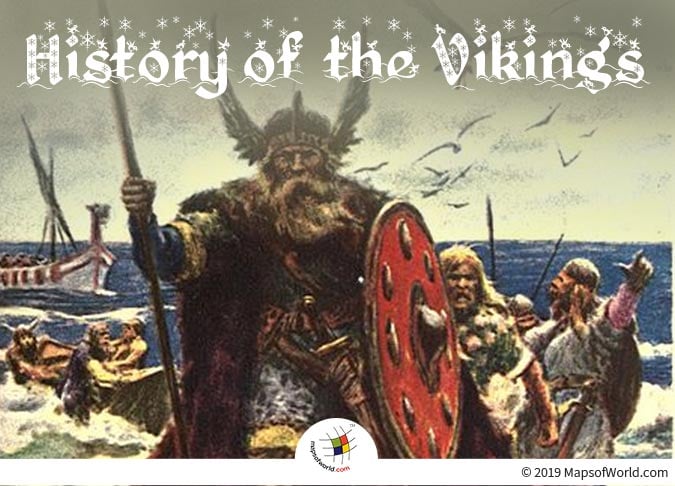

The End of the Viking Age can be attributed to the Events of the Year 1066 AD that took place in England.
From the beginning of the 9th century to the end of the 11th century, a large number of Scandinavians left their homeland in pursuit of fortunes. These came to be known as the Vikings. For the next three centuries, they were seen as nothing but traders, raiders, and pirates. They raided the coastal sites in the British Isles, and settled on a large portion of the European continent, including Newfoundland, Greenland, Iceland, and the modern-day Russia.
Contrary to popular belief, Vikings were not a race. What made them different was that they were perceived as violent and barbaric, in comparison to prevalent Christian culture and norms.
Europe was becoming richer in the 8th century. There was growth in the trading centers such as Quentovic, Hamwic, York, and Dorestad. Simultaneously, Scandinavian fur also started gaining popularity in these markets. These developments, as well as the advancements in sailing technology, attracted the attention of the Scandinavians. Based on this knowledge, Vikings began sailing expeditions into the North Sea.
The Viking Age’s beginning was marked by the attack on northeastern England’s Lindisfarne monastery. The Norwegians, who were likely behind the attack, didn’t completely destroy it, but it shook the religious world of Europe nonetheless. Moreover, the perception gained that these people had no regard for religious institutions. Two years down the line, the Vikings struck again when they raided the monasteries of Iona and Skye. The first ever record of their raid in Europe came in 799 AD, at a monastery near the Loire River’s estuary.
In the following decades, the Vikings continued raids in Europe and the British Isles. Having coming to know about Europe’s internal conflicts, they took advantage of that knowledge to expand their activities more into the inland. Lothar, the son of Emperor Louis the Pious, even asked for help from a Viking fleet in order to get an upper hand against his competing brothers. Soon, Frankish rulers began to pay huge sums to Vikings just so that the Vikings wouldn’t attack their subjects. In this way, Frankia, became a breeding ground for Viking activity.
By the middle of the 9th century, England, Scotland, and Ireland were the main targets of Vikings raids and settlements. Slowly, Vikings got their hands on large tracts of Scotland, including the Hebrides and the Northern Isles. They established their base on the Irish coast and launched attacks within the country from there. They also founded the first few trading towns in Ireland, namely, Limerick, Wicklow, Wexford, Waterford, and Dublin. However, in 862 AD, the Vikings confined themselves to England and became less active in Frankia, when King Charles the Bald started fortifying coastal areas, rivers, abbeys, and towns, thus defending West Frankia more aggressively.
Viking armies (of mostly Danish origin), settled in the north of England except for Wessex. The area came to be known as Danelaw. Gradually, most of them became traders and farmers. York was their major mercantile city.
Throughout the 9th century, Vikings were very active on the continent of Europe. In 842 AD, they ransacked Nantes. They also attacked Orleans, Limoges, Paris, and Nimes. In 844 AD, Seville was stormed by the Vikings, and Pisa was plundered in 859 AD. In 911 AD, the Vikings were granted Rouen and the territories surrounding it by the West Frankish king under a treaty, Rollo. Today, this region is known as the “land of the Northmen” or Normandy.
In the same century, Scandinavians started the colonization of Iceland. This region hadn’t had any settlement before then. By the end of the 10th century, Vikings had moved to Greenland. They temporarily settled in L’Anse aux Meadows, located in what is now known as Newfoundland, and called their region Vinland. Beyond this, there is not much proof of their presence in the New World.
The second Viking age began in the mid 10th century. Large-scale raids hit England and Europe’s coasts. Beginning in 991 AD, Sven Forkbeard raided England and had the whole kingdom under his rule in 1013 AD. However, he died the very next year, leaving his son Canute (or Knut) in charge of ruling the whole empire on the North Sea.
After the death of Canute, his two sons carried forward his legacy. However, by 1042 AD, they were dead too. Thereafter, Edward the Confessor (non-Danish), returning from exile, reconquered the English throne. He had no heirs. So, after his death in 1066 AD, the son of his most powerful noble, Harold Godwinesson claimed the throne. He later lost to the Duke of Normandy, William, who was later crowned on Christmas in 1066 AD. His empire resisted any further Danish attacks.
The end of the Viking age can be attributed to the events of the year 1066 AD that took place in England. By this time, Scandinavian kingdoms had turned Christian, and whatever ‘Viking culture’ was left was absorbed into the Christian Europe’s culture. Today, one can find the Viking legacy in Russia, Scotland, and England, and especially in Iceland, where they left huge literature highlighting their victories.
Related Links:
The Republic of Madagascar is an island country located in the Indian Ocean, off the…
The Euro is the official currency of the European Union. It is, however, not incumbent…
There are many countries or regions that are partially recognized by the UN, have disputes…
The Alaska Statehood Act was signed into law by President Dwight D. Eisenhower in 1958,…
The name Persia may, however, only be used to refer to Iran in some contexts.…
Hawaii is an Island State in the US. It is one of the 50 states…